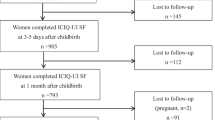Abstract
The epidemiology of urinary dysfunction in a Chinese population living in Hong Kong was investigated. Fifteen hundred ethnic Chinese women answered a telephone questionnaire including symptoms of urinary dysfunction, anthropometric measurements, obstetric history and place of birth. The relative predictive value of these factors was analyzed using logistic regression. The prevalence of urinary dysfunction was 13%. Ten percent reported stress incontinence, and 4% had urgency or urge incontinence. The strongest predictor was place of birth, with women born in mainland China having the highest prevalence of pure stress incontinence (OR 1.33, CI 1.1–1.6). For the symptoms of detrusor instability age was the strongest predictor, with women over 50 years being at greater risk (OR 2.8, CI 1.6–5.0). Contrary to earlier beliefs, urinary dysfunction in Chinese women is as common as in Caucasian women. Place of birth is the strongest predictor for pure stress incontinence, with women born in mainland China being at greater risk. This suggests that environmental factors in early life have a differential effect on the development of urinary incontinence.
Similar content being viewed by others
References
Zacharin RF. A Chinese anatomy — the pelvic supporting tissues of the Chinese and occidental female compared and contrasted.Aust NZ J Obstet Gynaecol 1977;17:1–11
Editorial comment.Aust NZ J Obstet Gynaecol 1996;36:52
Brieger GM, Yip SK, Hin LY, Chung TKH. The prevalence of urinary dysfunction in Hong Kong Chinese women.Obstet Gynecol 1996;8:1041–1044
Thomas TN, Plymat KR, Blannin J, Meade TW. Prevalence of urinary incontinence.Br Med J 1980;281:1243–1245
Sommer P, Bauer T, Nielson KK et al. Voiding patterns and prevalence of urinary incontinence in women. A questionnaire survey.Br J Urol 1990;66:12–15
Dwyer PL, Lee ET, Hay DM. Obesity and urinary incontinence in women.Br J Obstet Gynaecol 1988;95:91–96
Norton PA. Pathogenesis of stress urinary incontinence: the role of connective tissue. In: Ostergard DR, Bent AE, eds. Urogynaecology and Urodynamics: Theory and Practice. Baltimore: Williams and Wilkins, 1996;284–285
Sultan AH, Kamm MA, Hudson CN. Pudendal nerve damage during labour: prospective study before and after childbirth.Br J Obstet Gynaecol 1994;101:22–28
Snooks SJ, Swash M, Henry MM, Setchell M. Risk factors in childbirth causing damage to the pelvic floor innervation.Int J Colorectal Dis 1986;1:20–24
Engel AM, Kamm MA. The acute effect of straining on pelvic floor neurological function.Int J Colorectal Dis 1994;9:8–12
Brieger GM. Squatting and urinary dysfunction.Contemp Rev Obstet Gynaecol 1997 (in press)
Brieger GM, Yip SK, Fung YM, Chung TKH. Genital prolapse: a legacy of the west?Aust NZ J Obstet Gynaecol 1996;36:52–54
Lee SH. Annual departmental report by director of health for the financial year 1992–1993. Hong Kong: Department of Health, 1994.
Daryanani R, ed. Hong Kong 1995. Government information services. Hong Kong: Government Printing Department, 1995.
Hong Kong Telecommunications Ltd. Annual report 1990–91. Hong Kong: Hong Kong Telecommunications Ltd, 1991
Haylen BT, Sutherst JR, Frazer MI. Is the investigation of stress incontinence really necessary?Br J Urol 1989;64:147–149
Cardozo L, Cutner A, Wise B. Basic urogynaecology. Oxford: Oxford University Press, 1993
Demographic and Statistics Section, Census and Statistics Department. Hong Kong population projections 1992–2011. Hong Kong: Hong Kong Government, 1992
Jolleys JV. Reported prevalence of urinary incontinence in women in general practice.Br Med J 1988;296:1300–1320
Locher JL, Burgio KL. Epidemiology of incontinence. In: Ostergard DR, Bent AE, eds. Urogynaecology and urodynamics: theory and practice. Baltimore: Williams and Wilkins, 1996;67–73
Adlercreutz H, Honjo H, Higashi A et al. Urinary excretion of lignans and isoflavonoid phytoestrogens in Japanese men and women consuming a traditional Japanese diet.Am J Clin Nutr 1991;54:1093–1100
Ulsten U, Ekman G, Giettz G, Malmstrom A. Different biochemical composition of connective tissue in continent and stress incontinent women.Acta Obstet Gynecol Scand 1987;66:455–457
Barker DJ. The fetal origins of adult disease.Proc Roy Soc Lond B Biol Sci 1995;262:37–43
Author information
Authors and Affiliations
Additional information
EDITORIAL COMMENT: Taiwan Chinese women have a comparable prevalence of urinary dysfunction with Hong Kong Chinese women. A survey representing a multistage sample of 82 678 women aged 18 years or older was conducted in the Taipei area from January to June 1993. A total of 818 cases were interviewed by trained students. One hundred and eighty-nine (23.1%) of the respondents reported having had some degree of incontinence in the preceding 12 months, 28 (3.4%) reporting regular incontinence. Most presented with stress urinary incontinence, whereas urge incontinence and mixed incontinence were more commonly seen in the elderly group (aged 60 years or older). The risk factors for urinary incontinence included age, number of vaginal deliveries (>3), number of abortions (>2) and maternal history of incontinence. Voiding symptoms (irritative or obstructive) and constipation were significantly more prevalent among respondents with incontinence than those without (P<0.001). This evidence also indicates that the long-held belief that Chinese women have a much lower prevalence of urinary dysfunction than western women has all but ended.
Rights and permissions
About this article
Cite this article
Brieger, G.M., Mongelli, M., Hin, L.Y. et al. The epidemiology of urinary dysfunction in Chinese women. Int Urogynecol J 8, 191–195 (1997). https://doi.org/10.1007/BF02765811
Issue Date:
DOI: https://doi.org/10.1007/BF02765811




